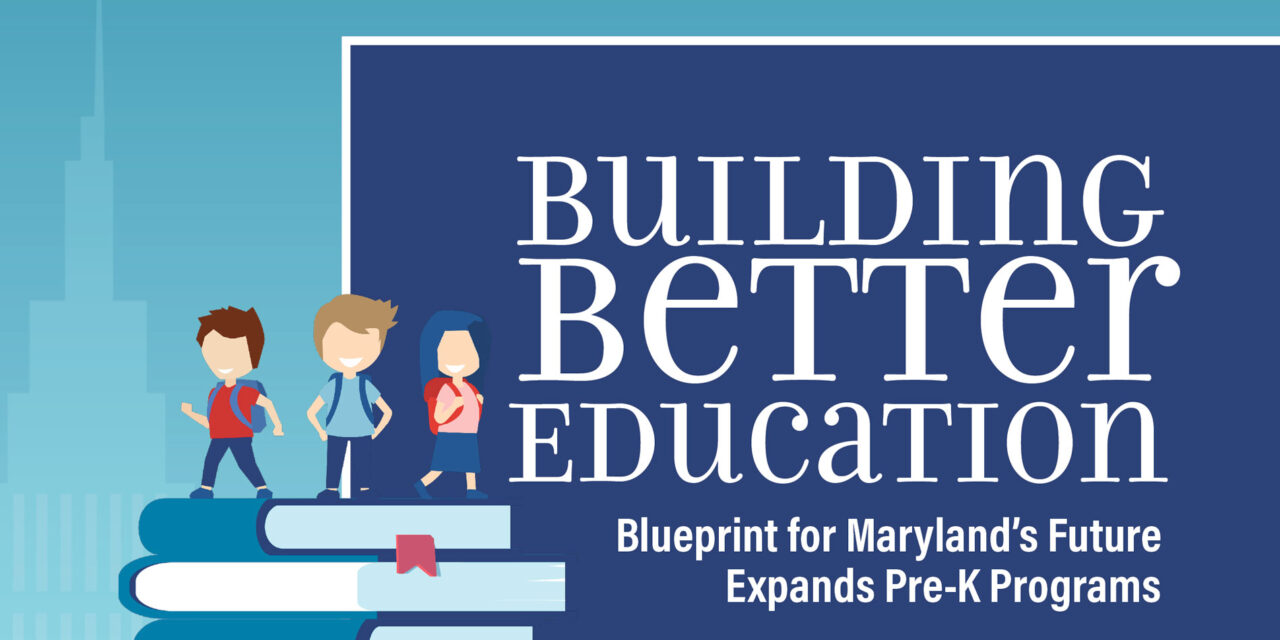by Amanda Milewski, photography by Nikola Tzenov
Blueprint for Maryland’s Future Expands Pre-K Programs
The Blueprint’s main goal is to improve the quality and equity of Maryland’s education system so that every student, “regardless of where they live, family income, race, ethnicity, gender, language spoken at home, special needs, and any other unique characteristic,” receives a “world-class education” that prepares them for long-term educational and professional success.
As anyone who has parented a toddler or preschooler knows, how they think, speak, and navigate the world changes daily. One day they are crawling, the next they are taking their first steps, and the next, they are running at full speed. And those who have older siblings are even more motivated to keep up with them. My youngest son learned to ride a two-wheeler at the age of 3, surely in part because he saw his brothers doing it. Parents of toddlers and preschoolers: Don’t blink!
Given the rapid pace at which 2- to 4-year-olds learn, it comes as no surprise that one of the five pillars of the Blueprint for Maryland’s Future is devoted to early childhood education, specifically 3- and 4-year-olds.
Established as state law by several pieces of legislation from 2018 to 2021, the Blueprint is based on suggestions that grew out of the Commission on Innovation and Excellence in Education, commonly called the Kirwan Commission after its chair, William “Brit” Kirwan. The Kirwan Commission was created by the governor and General Assembly in 2016 to recommend policy changes that will “enable Maryland’s education system to perform at the level of the world’s best systems and to review and recommend updated funding formulas.”
The Blueprint’s main goal is to improve the quality and equity of Maryland’s education system so that every student, “regardless of where they live, family income, race, ethnicity, gender, language spoken at home, special needs, and any other unique characteristic,” receives a “world-class education” that prepares them for long-term educational and professional success.
Brain gain
“Holistically, brain development and brain research has evolved so we know that early experiences are what set children up for success and for school readiness,” said Carole Williamson, associate professor of early childhood education at Carroll Community College. “Those first five years are critical,” she continued, “so pre-K really is what helps those youngest students start off on a successful trajectory as they enter kindergarten.”
Williamson also is the director of Littlest Learners, a child development center and lab school, located on the Carroll campus.
Involvement in a pre-K program is especially critical for children who may not have the exposure to educational and social experiences that are important in preparing them for more formal schooling or kindergarten, Williamson asserted. In those cases, early intervention can help prepare students so they can start kindergarten at the same level as their classmates.
Blueprint basics
The big change for early childhood education under the Blueprint program is that it provides voluntary, free full-day pre-K to 3- and 4-year-olds whose families have incomes up to 300 percent of the federal poverty level, which right now is $26,200 for a family of four. Eventually, pre-K will be offered for free on a sliding scale for families with incomes between 300 percent and 600 percent of the federal poverty level. This major expansion will ensure that all children enter kindergarten ready to learn.
Blueprint provides public funding for public school-based and community-based pre-K programs, both of which are required to meet rigorous quality standards, monitored by Blueprint’s Accountability and Implementation Board.
Blueprint also provides for a boost in tuition assistance and financial support for those earning degrees and credentials in early childhood education to increase the number of teachers available to accommodate for the pre-K expansion.
Carroll pre-K primer

“The full-day pre-K program will look like any other daylong grade-level program. Pre-K students will receive regular content areas like English/language arts, math, science, social studies, as well as special areas like health, music, art, physical education, and media. They also will receive lunch, have recess and a break/quiet time.” –STEVE WERNICK
Starting this fall, Carroll County Public Schools (CCPS) will offer full-day pre-K for 4-year-olds at 20 of the 22 elementary schools in the county. Mt. Airy Elementary, because it is only grades three through five, and Freedom Elementary, because of space limitations, are the two schools that don’t have pre-K programs.
Steve Wernick, director of curriculum and instruction for CCPS, explained that pre-K students whose home schools are Mt. Airy or Freedom would be placed in nearby schools with available seats.
Also new this year will be additional pre-K classrooms at Runnymede and Robert Moton elementary schools.
According to Pamela Meyers, CCPS supervisor of elementary education, “These additional classrooms are funded under the Pre-K Expansion grant and utilized the existing school facility. CCPS plans to continue expanding pre-K programming, so that each site has two classrooms to accommodate projected pre-K enrollment based on qualifying factors.”
Wernick added that “The full-day pre-K program will look like any other daylong grade-level program. Pre-K students will receive regular content areas like English/language arts, math, science, social studies, as well as special areas like health, music, art, physical education, and media. They also will receive lunch, have recess and a break/quiet time.”
The pre-K curriculum aligns to the Maryland Early Learning Standards, said Meyers. “Each program also must meet the Maryland EXCELS and accreditation process, aligning our developmentally appropriate practices to high-quality standards.”
Maryland EXCELS is the state’s quality rating system for child-care centers, school-age child care programs, family child care homes, and public pre-K programs. The ratings are available to families on the Maryland EXCELS website (marylandexcels.org) so they can make the best decision regarding child care/early education. Programs rated under the Maryland EXCELS program meet nationally recognized quality standards.
Getting your kids into pre-K
The application process for CCPS pre-K begins annually in April, but information regarding the program is advertised long before that through the school system, individual elementary schools and their newsletters, and in the Carroll County Times.
“Families complete an interest form in January, and the school registrar follows up with an application in mid-April,” said Meyers. “Once the application is completed, it, along with supporting documentation, is reviewed to determine eligibility. Children are either enrolled at that point or placed on a wait list should a space become available later.”
Supporting documentation includes verification of the child’s age, proof of residence and household income, according to Meyers.
“Any family who expressed interest and completed an application is considered,” said Meyers. “Should a program reach capacity and the family is eligible based on household income, the family is offered a space at another school. Should a program not reach capacity, the wait list is reviewed to fill the seats using priorities such as students with disabilities, those from households where English is not the primary language, or other identified risk factors,” Meyers explained.
People and places
The expanded CCPS pre-K program under Blueprint will require both additional teachers and additional classrooms, both Wernick and Meyers acknowledged.

“Those first five years are critical so pre-K really is what helps those youngest students start off on a successful trajectory as they enter kindergarten.” –CAROLE WILLIAMSON
Meyers said, “We utilize trend data and input from the community to plan for the continued expansion based on needs and interest. Projecting the number of seats, based on the family income levels and preferences, will inform decisions for facilities, staffing, and other resources.”
According to Wernick, each CCPS elementary school that offers pre-K has one classroom at the moment, but the expansion will require two.
In mid-June, the county Board of Education approved the addition of pre-K classrooms at Cranberry Station, Friendship Valley, Sandymount and Taneytown elementary schools. Construction of those additions are scheduled to occur between June 2025 and August 2026.
In addition to more space, the Blueprint expansion also will require more personnel. The maximum number of pre-K students per classroom is 20, led by a teacher and an assistant, maintaining the ratio of one adult per 10 students.
Pre-K teachers must have a bachelor’s degree as well as the appropriate teacher certification, and assistants are required to have an associate’s degree and/or a Child Development Associate certificate.
“As the pre-K programs expand, there is going to be a greater need for assistants since now every classroom will need one,” said Williamson.
“At Carroll Community College, we do both — instruct future teachers who can earn an associate’s degree in early childhood education and offer a Child Development Associate certificate through our non-credit department,” she explained.
Not just for public schools

“We utilize trend data and input from the community to plan for the continued expansion based on needs and interest.” –PAMELA MEYERS
The Blueprint’s pre-K expansion is not limited to pre-K only in Maryland’s public school systems. It also makes provisions for spaces at private pre-Ks for students from families who fall in that initial 300 percent of the federal poverty level category.
Williamson explained that she and staff from Littlest Learners were awarded a grant to fund six slots at the child development center through the Maryland State Pre-K Grant, administered by the Division of Early Childhood at the Maryland State Department of Education. The grant, previously funded through federal preschool grant funds and funds provided by the Maryland Prekindergarten Expansion Act of 2014, is now funded by the state as part of the Blueprint for Maryland’s Future.
“In order to qualify for an expansion grant, we had to be in the Maryland EXCELS rating system,” Williamson said. Centers applying for a grant needed to be rated at least a level 3. “We are currently a level 5, which is the highest rating,” she said. In addition, Littlest Learners is accredited by the Maryland State Department of Education, one of only 15 accredited centers in the county.
She expects that as that sliding scale moves toward the eligibility requirement of 600 percent of the federal poverty level, more children will be eligible to attend. “We definitely will continue to write the grant each year and we will add more children as more families qualify,” Williamson said.
She is excited that Littlest Learners has new spaces available as a result of the grant. They also were able to absorb another classroom and convert it to a new classroom for 4-year-olds. “We’re really looking forward to opening our center and showcasing our program,” to new students, she proclaimed

